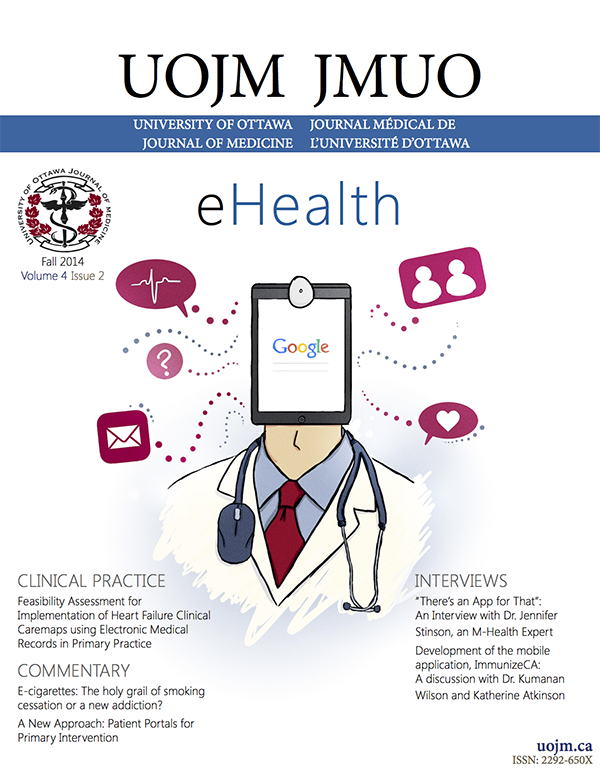Harm Reduction at its Best: A case for Promoting Safe Injection Facilities
DOI:
https://doi.org/10.18192/uojm.v4i2.1052Keywords:
Safe Injection Facilities, Harm ReductionAbstract
Injection Drug Users (IDU) represent less than 1% of Canada's the total population. Nevertheless, it is estimated that health and law enforcement costs for controlling the drug problem in Canada amount to $5 billion annually. The current strategies targeting IDU have limited efficacy with reducing emergency department visits, limiting HIV/Hep C virus transmission and providing accessible health care. This paper makes the case for safe injection facilities (SIF) as a means to improve IDU health outcomes, while reducing health care expenditures, decreasing public injecting and having no impact on crime rates. This topic is of particular concern now that the Conservative government is in the process of trying to pass bill C-2 to modify the Controlled Drugs and Substance Act making exemptions for SIF inaccessible. This is occurring while leading researchers in the field are applying for an exemption for such a facility in Ottawa.
References
Begin, P., Weekes, J. & Thomas, G. (2004). The Canadian addiction survey : Substance use and misuse among the Canadian population. Canadian Center on Substance Abuse. Retrieved from: http://www.csc-scc.gc.ca/publications/forum/e181/e181d_e.pdf
CBC News. (2013, August 31). Overdoses in Ottawa a preventable problem, say activists (2013). CBC news. Retrieved from: http://www.cbc.ca/news/canada/ottawa/overdoses-in-ottawa-a-preventable-problem-say-activists-1.1408951
Chitwood, D, D., McBride, D, C., French, M, T. & Comeford, M. (1999). Healthcare need utilization: A preliminary comparison of injection drug users, other illicit drug users and nonusers. Substance use & misuse. 35(4&5), 727-746. Retrieved from http://informahealthcare.com/loi/sum
Hilton B, A., Thompson, R., Moore-Dempsey, L. & Janzen, R, G. (2000). Harm reduction theories and strategies for control of immunodeficiency virus: A review of the literature. Journal of advanced nursing, 33(3), 357-370. doi:10.1046/j.1365-2648.2001.01672.x
MacAdam, M. (2008). Sustainability of Canada's health care system. Health Policy Monitor. Retrieved from http://www.hpm.org/survey/ca/b12/1
Marshall, B, D, L., Milloy, M-J., Wood, E., Montaner, J, S, G. & Kerr, T. (2011). Reduction in overdose mortality after the opening of North America's first medically supervised safer injecting facility: A retrospective population-based study. The Lancet, 377(9775), 1429-1437. doi: 10.1016/S0140-6736(10)62353-7.
National Institute on Drug Abuse. (1995). Methadone maintenance treatment: Translating research into policy. NISA Reseach Monograph Washington DC. National Institutes of Health, U.S. Public Health Services Retreived from: http://chodarr.org/sites/default/files/chodarr1448.pdf
Office of the Auditor General of Canada. (2001).2001 December report of the auditor general of Canada, Chapter 11—Illicit drugs: The federal government’s role. Retrieved from : http://www.oag-bvg.gc.ca/internet/English/parl_oag_200112_11_e_11832.html
Palepu, A., Tyndall, M, W., Leon, H., Muller, J., O'Shaughnessy, M, V., Schechter, M, T. & Anis, A, H. (2001). Hospital utilization and costs in cohort of injection drug users. Canadian Medical Association Journal, 165(4), 415-420. Retrieved from: http://www.ncbi.nlm.nih.gov/pmc/articles/PMC81365/
Pinkerton, S, D. (2010). Is Vancouver Canada's supervised injection facility cost-saving? Addiction, 105(8), 1429-1436. doi:10.1111/j.1360-0443.2010.02977.x
Wood, E., Kerr, T., Spittal, P, M., Tyndall, M, W., O’Shaughnessy, M, V. & Schechter, M, T. (2003). The health care and fiscal costs of the illicit drug use epidemic: The impact of conventional drug control strategies, and the potential of a comprehensive approach. BC Medical Journal, 45(3), 128-134. Retrieved from: http://www.bcmj.org/
Wood, E., Tyndall, M, W., Montaner, J, S., & Kerr, T. (2006). Summary of findings from the evaluation of a pilot medically supervised injecting facility. Canadian Medical Association Journal, 175 (11), 1399-1404. doi: 10.1503/cmaj.060863
Downloads
Published
Issue
Section
License
- Authors publishing in the UOJM retain copyright of their articles, including all the drafts and the final published version in the journal.
- While UOJM does not retain any rights to the articles submitted, by agreeing to publish in UOJM, authors are granting the journal right of first publication and distribution rights of their articles.
- Authors are free to submit their works to other publications, including journals, institutional repositories or books, with an acknowledgment of its initial publication in UOJM.
- Copies of UOJM are distributed both in print and online, and all materials will be publicly available online. The journal holds no legal responsibility as to how these materials will be used by the public.
- Please ensure that all authors, co-authors and investigators have read and agree to these terms.
- Works are licensed under a Creative Commons Attribution-NonCommercial-NoDerivatives 4.0 International License.


